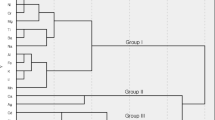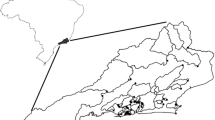Abstract
Urbanization impacts fluvial systems via a combination of changes in sediment chemistry and basin hydrology. While chemical changes in urban soils have been well characterized, similar surveys of riparian sediments in urbanized areas are rare. Metal concentrations were measured in sediments collected from riparian areas across the urbanization gradient in Baltimore, MD. Average metal concentrations are similar to those observed in other regional studies. Two important spatial patterns are evident in the data. First, calcium concentrations double across the urbanization gradient, regardless of changes in underlying geochemistry at the boundary between the Eastern US Piedmont and Coastal Plain physiographic provinces. Alkali-earth metal ratios indicate that the additional Ca is very pure and possibly arises from cement common to urban systems. Second, hot spots of trace metals typically associated with urban systems (e.g., Cu, Zn, and Pb) occur in areas that have been artificially filled to create additional real estate in high land value areas. Together, these data indicate that riparian sediments exhibit unexpected patterns of metal contamination. If these sediments are remobilized, during events such as droughts or floods, this contamination may perpetuate legacy impacts to ecosystem health from a history of fluvial contamination.





Similar content being viewed by others
References
Allmendinger NE, Pizzuto JE, Moglen GE, Lewicki M (2007) A sediment budget for an urbanizing watershed, 1951–1996, Montgomery county, Maryland, USA. J Am Water Resour Assoc 43(6):1483–1498
Bailey SW, Buso DC, Likens GE (2003) Implications of sodium mass balance for interpreting the calcium cycle of a forested ecosystem. Ecology 84(2):471–484
Bailey SW, Horsley SB, Long RP (2005) Thirty years of change in forest soils of the Allegheny Plateau, Pennsylvania. Soil Sci Soc Am J 69(3):681–690
Bain DJ, Brush GS (2005) Early chromite mining and agricultural clearance: opportunities for the investigation of agricultural sediment dynamics in the Eastern Piedmont (USA). Am J Sci 305(9):957–981
Bain DJ, Brush GS (2008) Gradients, property templates, and land use change. Prof Geogr 60(2):224–237
Bostick BC, Hansel CM, La Force MJ, Fendorf S (2001) Seasonal fluctuations in zinc speciation within a contaminated wetland. Environ Sci Technol 35(19):2823–3829
Burns D (2005) What do hydrologists mean when they use the term flushing? Hydrol Process 19(6):1325–1327
Burns DA, Hooper RP, McDonnell JJ, Freer JE, Kendall C, Beven K (1998) Base cation concentrations in subsurface flow from a forested hillslope: the role of flushing frequency. Water Resour Res 34(12):3535–3544
Carr J, Munn DA (2001) Agricultural disposal method of construction site gypsum wallboard waste. J Constr Educ 6(1):28–33
Choquette PW (1960) Petrology and structure of the Cockeysville Formation (pre-Silurian) near Baltimore, Maryland. GSA Bullet 71(7):1027–1052
Crowley WP (1977) Geologic map of the Reisterstown quadrangle, Maryland. Maryland Geological Survey, Baltimore
Crowley WP, Reinhardt J (1979) Geologic map of the Baltimore west quadrangle, Maryland. Maryland Geological Society, Baltimore
Elder JF (1988) Metal biogeochemistry in surface-water systems. USGS, Denver
Goguel RL, St John DA (1993) Chemical-identification of portland cements in New Zealand concretes.1. characteristic differences among New Zealand cements in minor and trace-element chemistry. Cem Concr Res 23(1):59–68
Graham IJ, Goguel RL, St John DA (2000) Use of strontium isotopes to determine the origin of cement in concretes: case examples from New Zealand. Cem Concr Res 30(7):1105–1111
Groffman PM, Boulware NJ, Zipperer WC, Pouyat RV, Band LE, Colosimo MF (2002) Soil nitrogen cycle processes in urban riparian zones. Environ Sci Technol 36(21):4547–4552
Grosbois C, Meybeck A, Horowitz A, Ficht A (2006) The spatial and temporal trends of Cd, Cu, Hg, Pb and Zn in Seine River floodplain deposits (1994–2000). Sci Total Environ 356(1–3):22–37
Hammer TR (1972) Stream channel enlargement due to urbanization. Water Resour Res 8(6):1530–1540
Hanan BB, Sinha AK (1989) Petrology and tectonic affinity of the Baltimore mafic complex, Maryland. Ultramafic Rocks of the Appalachian Piedmont: Geological Society of America Special Paper 231, pp 1–18
Helms D (2000) Soil and southern history. J Agric Hist 74(4):723–758
Hunt CB (1967) Physiography of the United States. W. H. Freeman and Company, San Francisco
Jacobson RB, Coleman DJ (1986) Stratigraphy and recent evolution of Maryland Piedmont flood plains. Am J Sci 286:617–637
Kaushal S, Groffman P, Band L, Shields C, Morgan R, Palmer M, Belt K, Swan C, Findlay S, Fisher G (2008) Interaction between urbanization and climate variability amplifies watershed nitrate export in Maryland. Environ Sci Technol 42(16):5872–5878
Knox JC (1987) Historical valley floor sedimentation in the Upper Mississippi Valley. Ann Assoc Am Geogr 77(2):224–244
Kuang C, Neumann T, Norra S, Stuben D (2004) Land use-related chemical composition of street sediments in Beijing. Environ Sci Pollut Res 11(2):73–83
Land M, Ingri J, Andersson PS, Ohlander B (2000) Ba/Sr, Ca/Sr and Sr-87/Sr-86 ratios in soil water and groundwater: implications for relative contributions to stream water discharge. Appl Geochem 15(3):311–325
Lovett GM, Traynor MM, Pouyat RV, Carreiro MM, Zhu WX, Baxter JW (2000) Atmospheric deposition to oak forests along an urban–rural gradient. Environ Sci Technol 34(20):4294–4300
Mahler BJ, Van Metre PC, Callender E (2006) Trends in metals in urban, reference lake sediments across the United States, 1970–2001. Environ Toxicol Chem 25(7):1698–1709
Marron DC (1992) Floodplain storage of mine tailings in the Belle Fourche River system: a sediment budget approach. Earth Surf Proc Land 17:675–685
Marvin E (2000) Gypsum wallboard recycling and reuse opportunities in the state of Vermont. Waste Management Division, Vermont Agency of Natural Resources, Montpelier, p 42
Mason RP, Kim E-H, Cornwell J (2004) Metal accumulation in Baltimore Harbor: current and past inputs. Appl Geochem 19(11):1801–1825
McGrain JW (1985) From pig iron to cotton duck: a history of manufacturing villages in Baltimore County. Baltimore County Public Library, Towson
McLaughlin SB, Wimmer R (1999) Tansley review no. 104 calcium physiology and terrestrial ecosystem processes. New Phytol 142(3):373–417
Mekiffer B, Wessolek G, Vogeler I, Brettholle M (2010) Sulphate release from building rubble of WWII. In: EGU General Assembly, Vienna
Mielke HW, Gonzales CR, Smith MK, Mielke PW (2000) Quantities and associations of lead, zinc, cadmium, manganese, chromium, nickel, vanadium, and copper in fresh Mississippi delta alluvium and New Orleans alluvial soils. Sci Total Environ 246(2–3):249–259
Miller JR (1997) The role of fluvial geomorphic processes in the dispersal of heavy metals from mine sites. J Geochem Explor 58:101–118
Miller A, Schimel J, Meixner T, Sickman J, Melack J (2005) Episodic rewetting enhances carbon and nitrogen release from chaparral soils. Soil Biol Biochem 37(12):2195–2204
Nath B, Norra S, Chatterjee D, Stuben D (2007) Fingerprinting of land use-related chemical patterns in street sediments from Kolkata, India. Environ Forensics 8(4):313–328
National Atmospheric Deposition Program (NRSP-3) (2008). Illinois state water survey. National atmospheric deposition program (NRSP-3), Champaign
Nehls T, Rokia S, Mekiffer B, Wessolek G (2010) Rooting the rubble-nutrient storage of bricks in urban soils. In: EGU General assembly, Vienna
Oktay SD, Brabander DJ, Smith JP, Kada J, Bullen TD, Olsen CR (2003) WTC Geochemical fingerprint recorded in New York harbor sediments. Eos Trans AGU 84(3):21
Pouyat R, McDonnell M (1991) Heavy metal accumulations in forest soils along an urban–rural gradient in southeastern New York, USA. Water Air Soil Pollut 57(1):797–807
Pouyat RV, McDonnell MJ, Pickett STA (1995) Soil characteristics of oak stands along an urban–rural land-use gradient. J Environ Qual 24(3):516–526
Pouyat RV, Yesilonis ID, Russell-Anelli J, Neerchal NK (2007) Soil chemical and physical properties that differentiate urban land-use and cover types. Soil Sci Soc Am J 71(3):1010–1019
Pouyat RV, Yesilonis ID, Szlavecz K, Russell-Anelli J, Giorgio V, Csuzdi C, Hornung E, Korsos Z (2008) Response of forest soil properties to urbanization gradients in three metropolitan areas. Landsc Ecol 23:1187–1203
Rogers CE, Brabander DJ, Barbour MT, Hemond HF (2002) Use of physical, chemical, and biological indices to assess impacts of contaminants and physical habitat alteration in urban streams. Environ Toxicol Chem 21(6):1156–1167
Sinex SA, Helz GR (1981) Regional geochemistry of trace elements in Chesapeake Bay sediments. Env Geol 3:315–323
Sinex SA, Helz GR (1982) Entrapment of zinc and other trace-elements in a rapidly flushed industrialized harbor. Environ Sci Technol 16(11):820–825
USGS (1999) Maryland land cover data set. In: U. S. Geologic Survey, Sioux Falls, SD
Walsh CJ, Roy AH, Feminella JW, Cottingham PD, Groffman PM, Morgan RP (2005) The urban stream syndrome: current knowledge and the search for a cure. J N Am Benthol Soc 24(3):706–723
Weiss J (1949) Wissahickon schist at Philadelphia, Pennsylvania. Geol Soc Am Bull 60:1689–1726
Whittier T, Ringold P, Herlihy A, Pierson S (2008) A calcium-based invasion risk assessment for zebra and quagga mussels (Dreissena spp). Front Ecol Environ 6(4):180–184
Wolman MG (1967) A cycle of sedimentation and erosion in urban river channels. Geogr Ann 49A(2–4):385–395
Yesilonis ID, Pouyat RV, Neerchal NK (2008) Spatial distribution of metals in soils in Baltimore, Maryland: role of native parent material, proximity to major roads, housing age and screening guidelines. Environ Pollut 156(3):723–731
Acknowledgments
The authors wish to thank the US Geological Survey Water Resources Division, and Tom Bullen and John Fitzpatrick in Menlo Park, CA for hosting DJB. Funding support was provided by the US Forest Service’s Northern Global Change Program and Research Work Unit (NE-4952), Syracuse, NY; the Baltimore Ecosystem Study (part of the LTER Program) grant from the National Science Foundation (Grant No. 0423476); the University of Maryland Baltimore County, Center for Urban Environmental Research and Education grants from the National Oceanic and Atmospheric Administration (NA06OAR4310243 and NA07OAR4170518); and the University of Pittsburgh College of Arts and Sciences. Most importantly, thanks to the individuals responsible for the collection and processing of core samples analyzed in this work.
Author information
Authors and Affiliations
Corresponding author
Rights and permissions
About this article
Cite this article
Bain, D.J., Yesilonis, I.D. & Pouyat, R.V. Metal concentrations in urban riparian sediments along an urbanization gradient. Biogeochemistry 107, 67–79 (2012). https://doi.org/10.1007/s10533-010-9532-4
Received:
Accepted:
Published:
Issue Date:
DOI: https://doi.org/10.1007/s10533-010-9532-4




